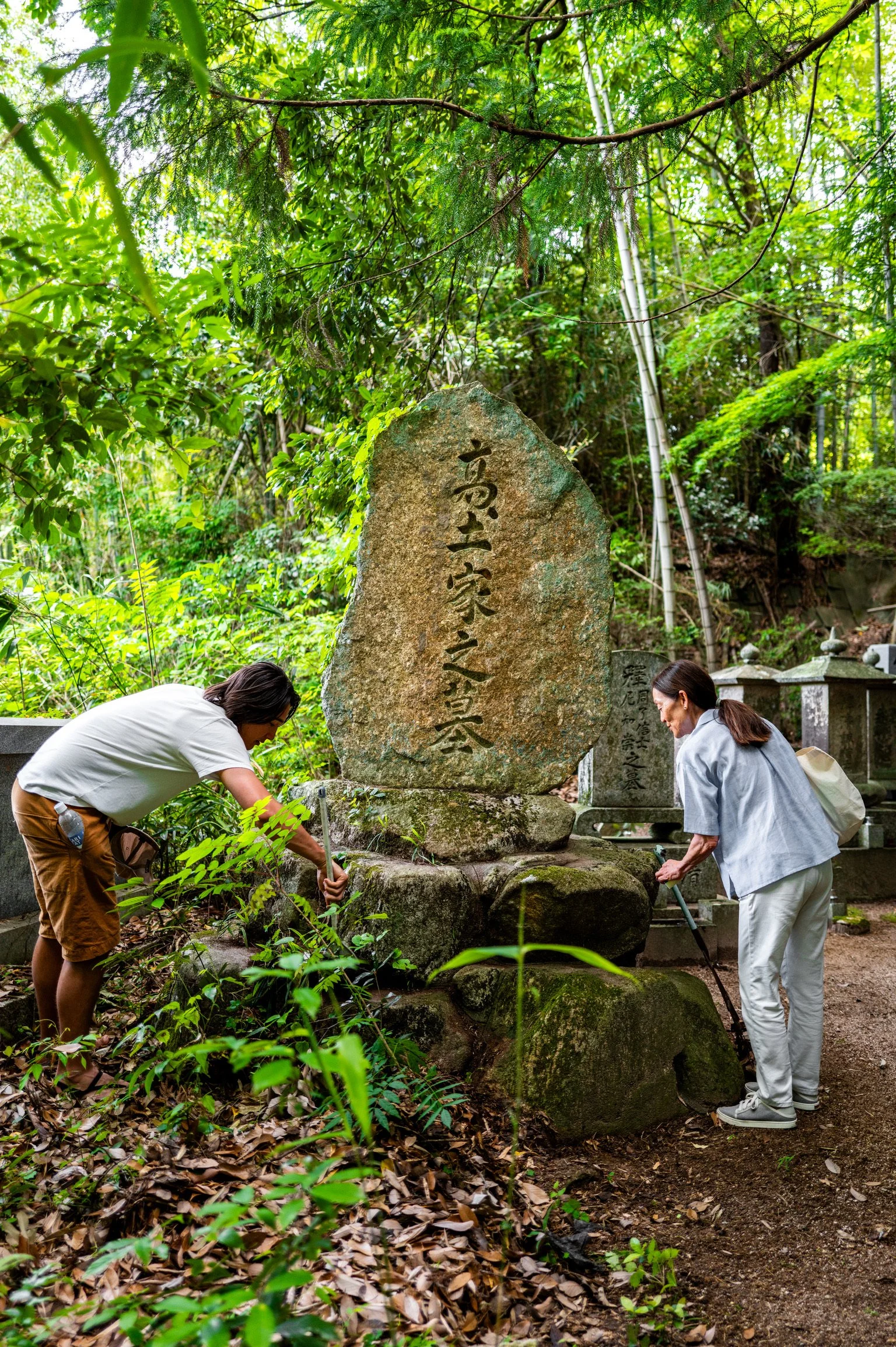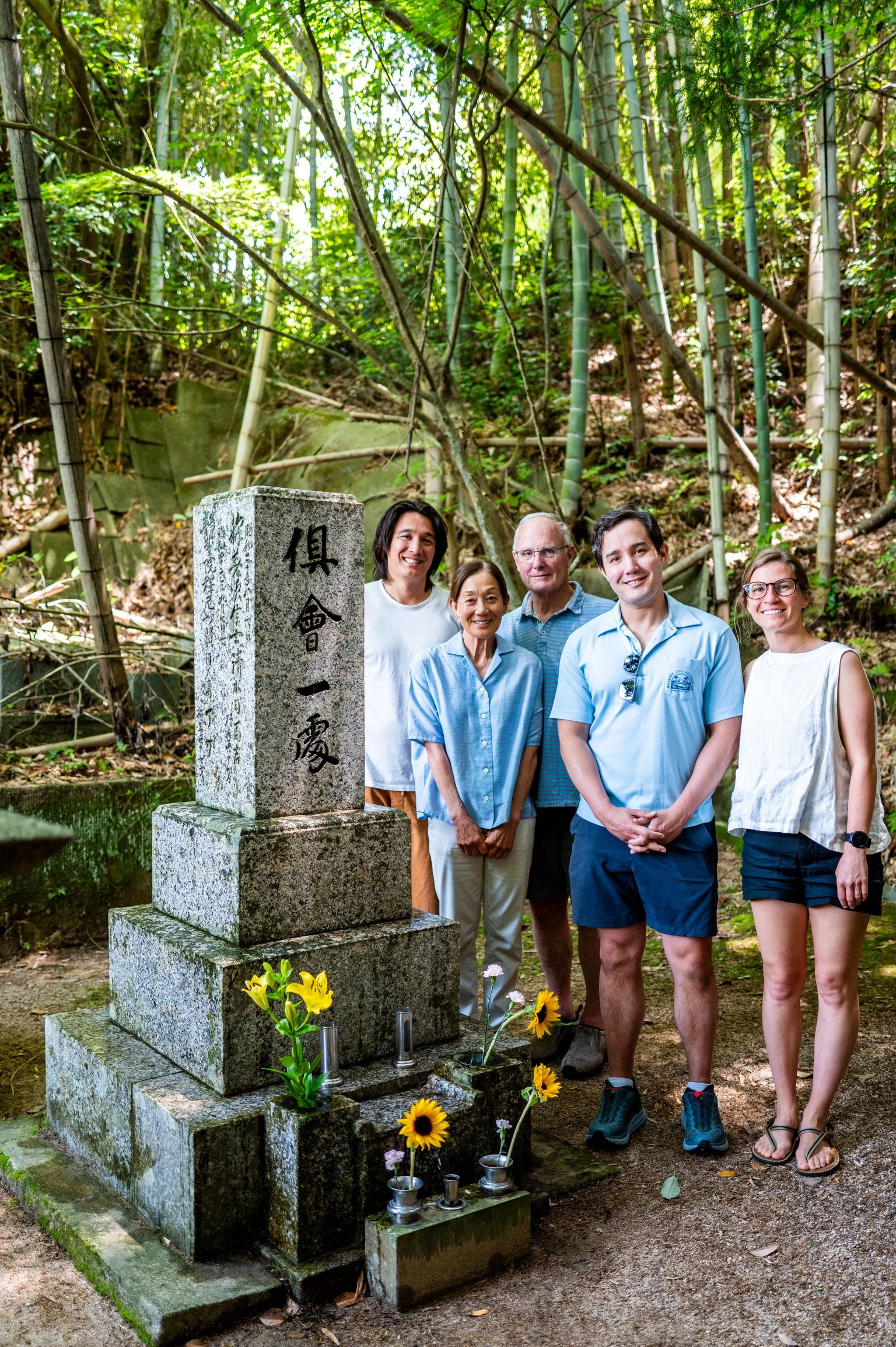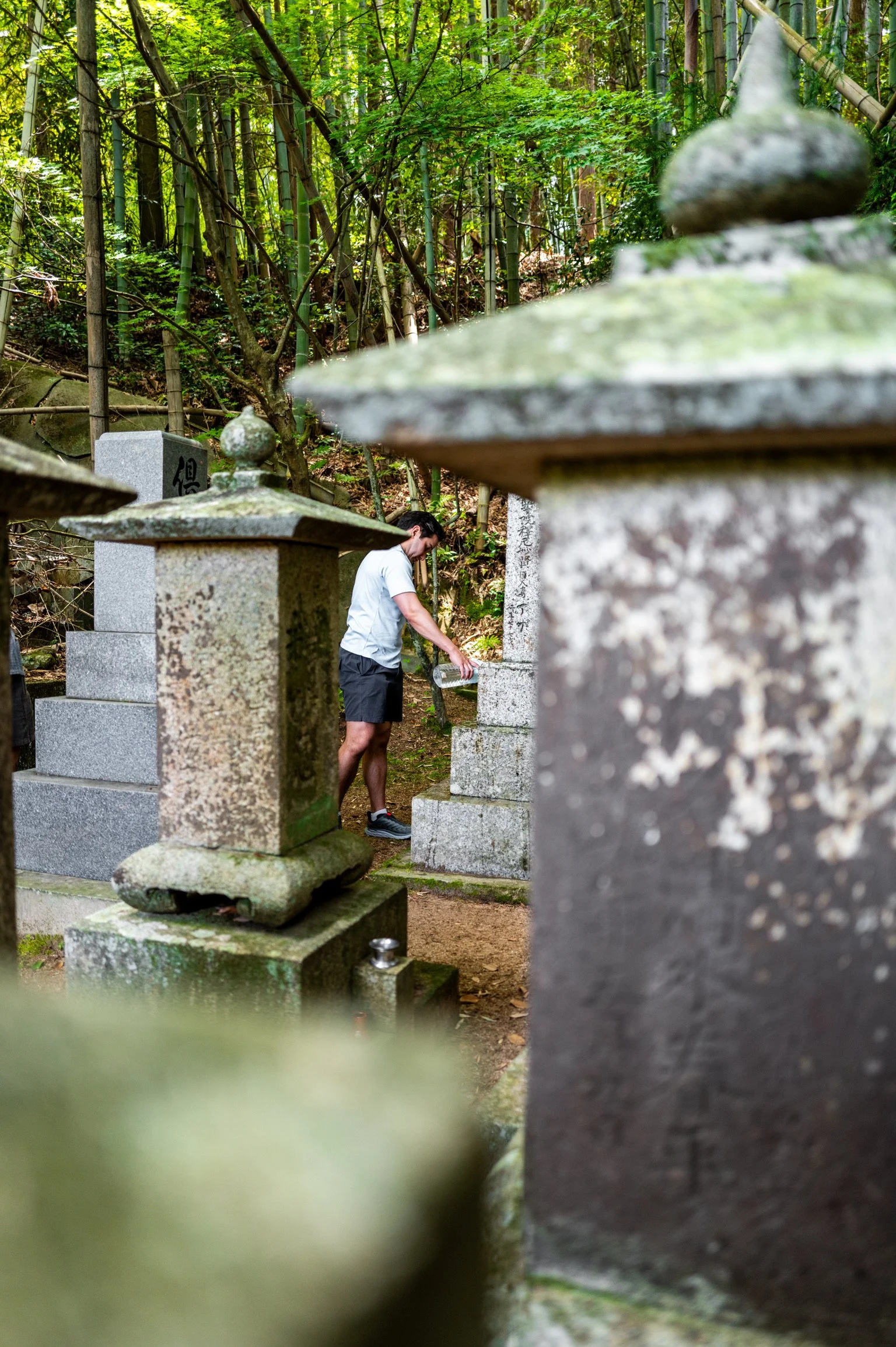How to Honor Ancestors Through Ceremony: Our Family Story
Huddled around the autobiography of my husband’s grandfather, Ben Shimizu, we tilted our heads, puzzling over the map he drew. Just half an hour earlier, we had been dropped off along an old country road outside of Hiroshima, rice fields terraced around us. Our task felt both daunting and sacred: to find the ancestral family cemetery plot where more than seven generations of the Shimizu family rest.
“Our graveyard site is located in Hagiwara, a locale in Kumano, on the west side of a small hill, called Ryu-o-zan, a dragon-king hill, upon which stands an old shrine…Before beginning our ascent up the hill, we would stop to visit one of our relatives to freshen the flowers we had brought to place on the graves and to borrow a bucket filled with water.” - Ben Shimizu
Another half hour passes as we scanned rows of ancient tombstones, hoping to find the family crest. With every bend in the road came another hillside crowded with dark grey tombstones. My heart sank as the thought creeped in, “will we ever find it?” Truth be told, this was the central reason for our trip to Japan. It had been more than twenty years since my husband’s family had traveled together to Japan. Twenty years since they’d visited their ancestors at the family cemetery.
The feeling of hopelessness was creeping in around us, threatening to be the prevailing mood. Out of a sense of obligation, our driver hustled around by foot to help us find our way, sweat forming on his shiny bald head. At some point, my husband and his brother walked ahead as my father-in-law and I lingered behind, methodically checking each of the tombstones we passed. My mother-in-law clutched her father’s book, scanning the map again and again.
Suddenly, an excited yelp broke the silence. The driver had discovered a hidden trail leading us through the bamboo. We walked along the unkept trail, and emerging from the thicket, we found ourselves before the key landmark: a grand Shinto shrine.
Since we came from behind, we circled around to the front of the Shinto shrine and paid our respects: dropping in a coin, pulling the rope to ring the bell, bowing twice, clapping twice to announce ourselves to the kamis (gods), then bowing once more with a prayer. The masks lining the shrine walls were watchful and mysterious. The place felt otherworldly, like stepping into a Miyazaki film, where reverence and silence create space for unseen beings to join us. We had entered liminal space, and the ceremony was upon us.
Yet the family cemetery was still elusive. Looking around, we were surrounded by tombstones scattered throughout the hillside on terraced land. My gaze lingered on the hollow eyes of the shrine masks, stuck in a timeless stare down. A distant crow’s caw broke the spell. My brother-in-law turned toward the sound and in the exact direction of the family cemetery. “This way!” he shouted. I bowed once more, a nervous curtsy steeped in fear and gratitude before hurrying to join my family.
We passed beneath a torii gate, bowed once to the kami, a snake slithered away retreating into the forest, as if signaling for us to continue.
And then, there it was. Tucked away protected by the bamboo forest, there was our family plot. My mother-in-law held up her father’s autobiography, flipping it to an earmarked page where a photo of her parents stand beside a large tombstone about 10 feet tall. We looked up. The same exact tombstone stood before us, unchanged through the decades.
We found it. Relief washed over us along with smiles and joyful cheering. Now, it’s time for the ceremony!
Holding an Ancestor Honoring Ceremony
From the Day of the Dead in Mexico to Chuseok in Korea, people across the globe pause to remember their ancestors. In Vietnam, people light incense at family altars; in Ghana, elaborate festivals celebrate lineage; in China, the Qingming Festival invites families to clean graves and offer food. While the forms differ, the intention is universal: to honor those who came before us, to remember, and to maintain connection.
When planning the trip, my mother-in-law shared how important it would be to visit her family plot. As a trained Buddhist eco-chaplain who finds joy in holding contemplative spaces, I offered to guide a ceremony to honor the ancestors. She agreed—perhaps unsure what that would mean, but glad to welcome me into the process.
In my chaplaincy training with the Sati Center for Buddhist Studies, I learned the art of holding open, compassionate space for others: practicing deep listening, recognizing the dignity in each person, and creating rituals that mark thresholds in life. And though I am not Japanese myself, after spending extensive time walking pilgrimage in Japan and learning from my mother-in-law about Japanese culture, I appreciate how central ancestor honoring is within the culture, through household altars called butsudans and offerings (incense, fruit, etc.) that combine gratitude and remembrance into daily life. Leading this ceremony felt like a way to bring my training into harmony with a tradition that already holds such a meaningful place in my husband’s family.
There is no single “right way” to honor ancestors. What matters most is holding an attitude of reverence and care, and I knew that a key part of the ceremony would revolve around cleaning the gravestones, so we stopped by a supermarket before getting dropped off near the grave site and we had all the supplies we needed ready to go.
Entering Liminal Space
When preparing for ceremony, it is helpful to know that you are moving into liminal space, which is a special time and place that often feels dreamlike or mystical. The term ‘liminal’ is from the late 19th century, from the Latin word “limen” meaning ‘threshold’. In my eco-chaplaincy training, our cohort started calling ourselves “thresholders” because as chaplains, we often find ourselves residing at this meaningful, timeless space, and I have to say, it’s a pretty cool place to hang out. And “threshold'“ is the perfect way to describe the liminal space that’s created through ceremony. You’re moving into the “in between moments”, no longer in the space of what’s happened before or after the ceremony, completely present with right now, with your thoughts, emotions, and all that goes on into this moment. Often, ceremonies take place in a threshold of a big transition like birth celebrations or funerals. In this particular ceremony, you’re in the liminal of the living and the dead, holding space for this time and place to connect with your ancestors, those who you know and those you’ve never met.
Ceremony Elements
Below are some elements you might include if you’d like to create a similar ancestor honoring ceremony of your own:
1. Preparation and Intention Setting
Choose a place that feels connected to your lineage: a family grave, a natural place, a special place within family line, or even a quiet place in your home.
Gather simple items such as water, flowers, incense, candles, or objects that feel meaningful to you.
Set an intention for the ceremony
Example: My intention for this ceremony is to honor my loved ones so that I can feel more connected to their wisdom and guidance in my daily life.
2. Reflection and Prayer
Take a few moments of silence to breathe and feel your connection across generations. It can be helpful to bring in the elements as a way to really ground in the present moment.
You might also offer a prayer, poem, song, or delight in memories of your loved ones.
For our ceremony, I chose to honor our ancestors past, present and future by gathering in a circle, connecting with those who have come before us, all the lessons learned, wisdom, and resilience, speaking their names out loud, carrying them with us in our hearts. Ending the ancestors of the past with a deep bow. This is also a time when we told stories and shared the qualities of the people in our ancestry line, maybe the stories we’ve heard about them, the qualities of who they are based on the stories passed down from generation to generation.
Then, we honored the present – taking a moment to make eye contact with each of the members of our family, speaking your name, recognizing your place in the family line, trusting your own wisdom and path. So each person does this and the others witness. Taking a moment of silence and bowing to each other.
Finally, we honor the ancestors of the future, to whom we care for even before knowing. We reflected on the task of our future family, wishing them a beautiful, fruitful life that holds in it all that we’ve learned in this lifetime, sending them a heartfelt bow of deep gratitude for their gifts and what they will contribute to our world.
Because this ceremony was held within a bit of a “call to action” so to speak, to make the most of our time on earth for our own sake and also for the sake of our past and future ancestors. This is so that the ancestors of the past haven’t gone in vain, that we’ve learned from them and will continue to bring their lessons forward for the better of the planet and the world we live in. And also for the future ancestors, to wish that what we do now, how we live our lives right now, will benefit their lives and the planet that they will be living in. So I chose a poem that captured the feeling of this wish for my family:
When Death Comes by Mary Oliver
When death comes
like the hungry bear in autumn;
when death comes and takes all the bright coins from his purseto buy me, and snaps the purse shut;
when death comes
like the measle-poxwhen death comes
like an iceberg between the shoulder blades,I want to step through the door full of curiosity, wondering:
what is it going to be like, that cottage of darkness?And therefore I look upon everything
as a brotherhood and a sisterhood,
and I look upon time as no more than an idea,
and I consider eternity as another possibility,and I think of each life as a flower, as common
as a field daisy, and as singular,and each name a comfortable music in the mouth,
tending, as all music does, toward silence,and each body a lion of courage, and something
precious to the earth.When it's over, I want to say all my life
I was a bride married to amazement.
I was the bridegroom, taking the world into my arms.When it's over, I don't want to wonder
if I have made of my life something particular, and real.I don't want to find myself sighing and frightened,
or full of argument.I don't want to end up simply having visited this world.
-Mary Oliver
3. Cleaning and Care
If you’re at a gravesite, begin by tidying the area: sweep leaves, wash the stone with water and soap if needed.
If at home, you might prepare an altar with photos and mementos.
If you’re doing this ceremony with others, invite silence during this part of the ceremony. Silence creates an environment of reverence so that the space between you and your loved ones feels closer. Setting the container of silence helps everyone avoid nervous small talk, which takes away from deepening into the ceremony.
4. Offering
Pour a little water, light incense, or place food or flowers.
Reflect in gratitude for your ancestors.
5. Closing
Bow, place your hands together, or offer any gesture of respect that feels authentic.
Afterwards, you can journal about how that was for you, or if you’re in a group, take time to debrief. Know that the ceremony lives in you as you continue on your path, with hopefully a more assured sense of support from your ancestors.
These ceremonies are less about getting it right and more about sincerity. By tending a tombstone, lighting a stick of incense, or simply pausing to remember and say a quick prayer, we strengthen the ties of belonging between ourselves, our ancestors, and the world around us. We strengthen our ties between the regular world and the unseen magic that’s always lying just beneath the surface if only we took a moment to listen and look. When we see the world with new eyes in this way, we’ll see that we’re always supported. And that is the beauty of ceremony, the beauty of connecting with our ancestors.
I hope this article was beneficial. I hope that it is something that inspires you to practice the beautiful art of honoring our ancestors. Thank you for reading!















